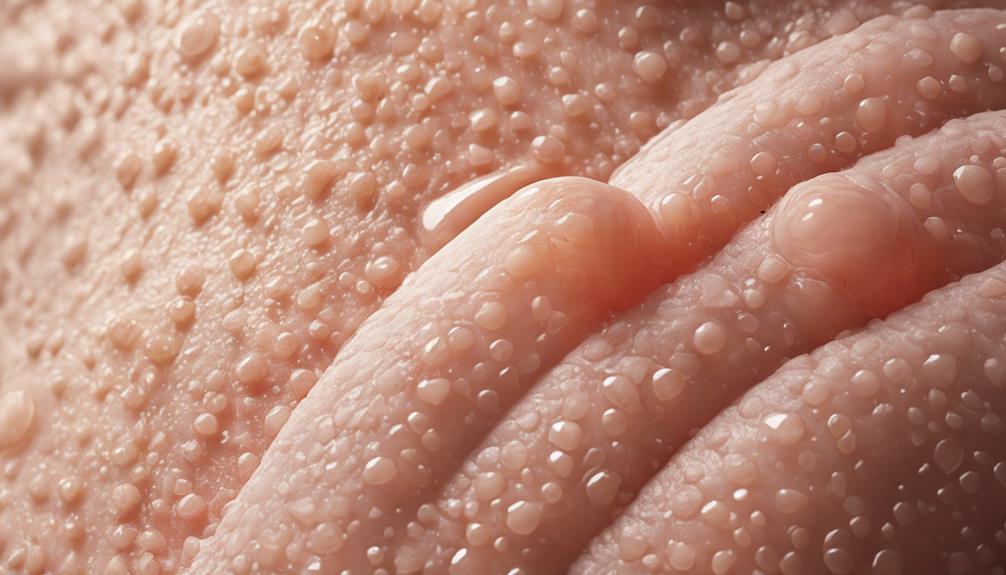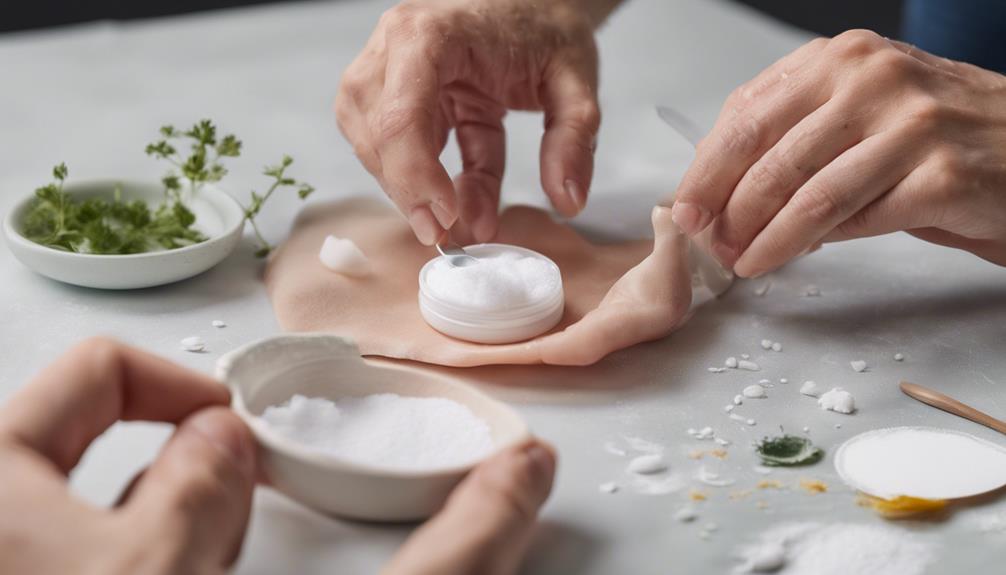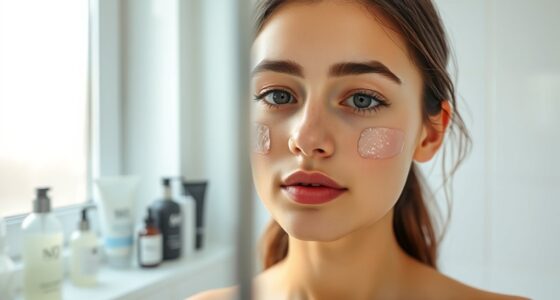When using **pimple patches** after skincare, apply them on **clean, dry skin** for better adhesion and effectiveness. Gently cleanse and ensure your skin is dry, avoiding moisturizers to allow the patch to work effectively. Apply it on areas with a **whitehead or blemish**, press gently for contact, and leave it on **overnight**. Enhance the benefits by refraining from using toners or lotions on the patch areas, while keeping the rest of your skin well-hydrated with suitable moisturizers for overall skin health. By following these steps, you’ll achieve the best results from your pimple patches. Discover more tips to improve your skincare routine. Start now for healthier, clearer skin. Layering skincare with pimple patches can significantly improve your overall routine, as it allows targeted treatment while maintaining skin hydration elsewhere. To maximize the effects, consider incorporating calming ingredients like niacinamide or green tea extract in your daily skincare regimen, which can complement the healing process. By combining these strategies, you’ll create a balanced approach that not only addresses breakouts but also promotes a radiant and healthy complexion.
Key Takeaways
- Apply pimple patches on clean, dry skin after skincare routine.
- Target whitehead pimples for maximum absorption of impurities.
- Avoid using toners or lotions on patch areas.
- Ensure patches adhere well by pressing gently after application.
- Let patches work overnight for 6-8 hours for best results.
Preparing Clean, Dry Skin for Patches
To prepare clean, dry skin for pimple patches, start by cleansing your face with a gentle cleanser to remove dirt, oil, and impurities.
It's important to make sure your skin is completely dry after cleansing so the pimple patch adheres properly. Avoid applying any skincare products like toners or moisturizers on the area where you plan to place the patch for it to work effectively.
After patting your skin dry with a clean towel, you're ready to apply the pimple patch on the clean, dry area with a whitehead or blemish for best absorption and effectiveness.
Avoiding Moisturizer Over Patch Areas

We should avoid applying moisturizer directly over the areas where pimple patches will be placed to guarantee maximum absorption and effectiveness. Moisturizers can create a barrier that hinders the patch's ability to draw out impurities from the skin. By keeping these areas free of moisturizer, we allow the patch to work more efficiently in its healing process.
To make sure that the pimple patch can adhere properly to the skin, it's essential to apply it to clean, dry skin. Moisturizer residue can interfere with the patch's adhesion and effectiveness. By skipping moisturizer over the patch areas, we promote better contact between the patch and the skin, allowing it to stay in place and work its magic uninterrupted.
Ensuring Proper Adhesion of Patches
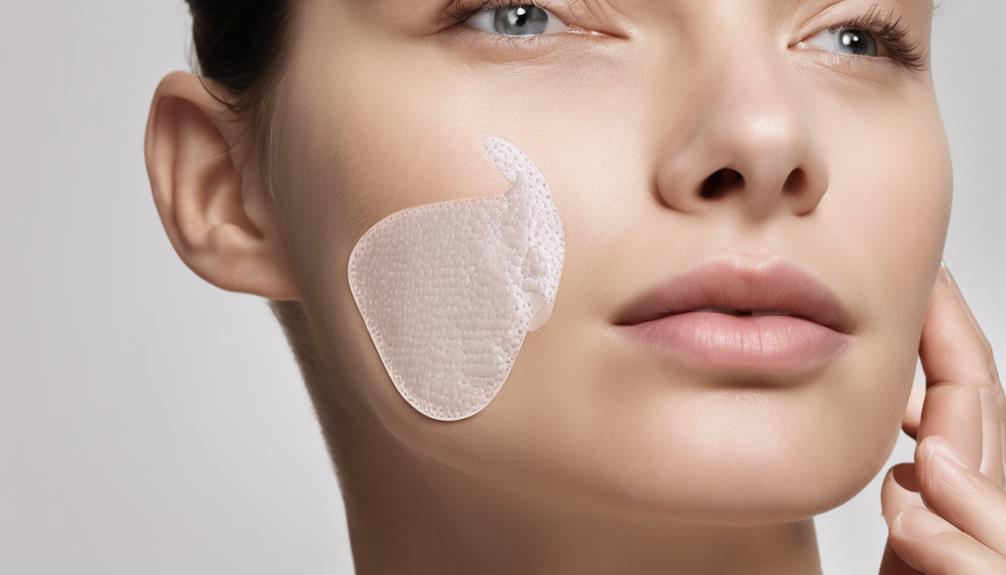
For essential adhesion of pimple patches, make sure the skin is clean and completely dry before application. This step is vital in guaranteeing that the patch sticks well to the skin and stays in place throughout the night. By keeping the area free of any moisture or residue from skincare products, you can maximize the effectiveness of the patch in targeting the pimple.
Avoid applying toners, lotions, or any other products that could create a barrier between the patch and your skin. After applying the patch, gently press down on it to help it adhere securely. This simple action can make a big difference in how well the patch stays in place and delivers its benefits to the pimple.
To achieve the best results, consider applying the pimple patch immediately after your skincare routine or cleansing. This timing ensures that the patch can adhere properly to the clean and dry skin, optimizing its adhesion and effectiveness in treating the pimple.
Maximizing Patch Benefits Overnight

Maximize the benefits of pimple patches overnight by applying them directly on clean, dry skin after your nighttime skincare routine. This simple step guarantees that the patch adheres well and can work effectively throughout the night.
By placing the pimple patch on whitehead pimples, you allow it to absorb pus and impurities efficiently, promoting clearer skin by morning. Remember to skip applying toners or lotions on the areas where you plan to use the patch to maintain its adhesion and maximize its benefits.
Let the patch do its magic for 6-8 hours while you sleep, aiding in reducing the size and redness of your pimple. Upon waking up, gently remove the patch to reveal a visibly clearer and healthier complexion.
Overnight application of pimple patches on clean, dry skin is a simple yet effective way to target those pesky pimples and wake up to a more confident you.
Hydrating Uncovered Skin Areas

Before applying pimple patches, it's essential to hydrate any uncovered skin areas with moisturizer and serums. This helps maintain overall skin health while targeting specific blemishes with the patches.
Moisturizing Bare Skin
To maintain hydration and balance after applying pimple patches, moisturize the areas of your skin left uncovered. This step helps in preventing dryness and supports the skin barrier integrity.
Focusing on the bare skin areas not covered by the pimple patches is essential for keeping your skin hydrated and nourished. By applying moisturizer to these exposed areas, you can prevent moisture loss and promote overall skin health.
It's vital to choose a moisturizer suitable for your skin type that complements the effectiveness of the pimple patches. Remember, keeping these uncovered skin areas well-moisturized is key to achieving a healthy and balanced complexion.
Nourishing Exposed Areas
For best skincare results, make sure to hydrate the exposed areas of your skin that aren't covered by pimple patches with a suitable moisturizer.
When nourishing these areas, consider the following:
- Hydrating the skin helps the patches adhere better, ensuring they stay in place for effective treatment.
- Moisturizing uncovered areas can help in extracting impurities from the skin, promoting clearer skin.
- Adequately hydrated skin accelerates healing processes, aiding in faster recovery from blemishes.
- By focusing on nourishing the exposed skin, you provide a conducive environment for the skin to repair itself and maintain its health.
Hydrating Uncovered Spots
When applying pimple patches, make sure to target and hydrate uncovered dry skin areas to maximize adhesion and effectiveness. Before placing the patch on hydrating spots, make certain the skin is clean and dry.
Patches work best on areas without moisturizer or lotions, allowing them to adhere properly. Directly applying the patch on dry skin enables maximum absorption of impurities.
Hydrating uncovered spots with pimple patches can help target specific areas for treatment. By focusing on these dry skin areas, the patches can adhere better and work more effectively.
Promoting Clearer, Healthier Skin
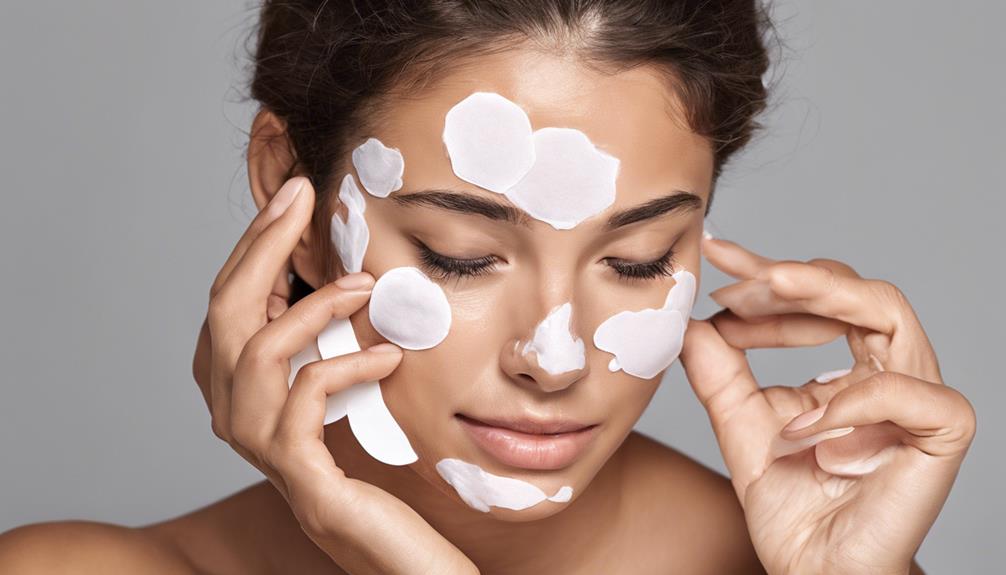
When aiming to achieve clearer, healthier skin, targeted spot treatment using pimple patches is key.
These patches deliver overnight blemish care by adhering directly to the pimple, aiding in extracting impurities and promoting faster healing.
Targeted Spot Treatment
To effectively target spot treatment for clearer, healthier skin, place pimple patches directly on clean, dry skin after completing your skincare routine.
- Pimple patches should adhere to active whiteheads or blemishes to draw out impurities effectively.
- The patch helps absorb excess oil, pus, and bacteria to reduce inflammation and redness.
- Placing the patch on clean skin guarantees secure adhesion and encourages faster blemish recovery.
- By targeting specific areas with pimple patches, you can prevent further irritation and promote quicker resolution of blemishes.
Overnight Blemish Care
For ideal overnight blemish care promoting clearer, healthier skin, apply pimple patches on clean, dry skin after completing your skincare routine. Make sure your face is free from any product residue before putting on the hydrocolloid patches to enhance their effectiveness.
Directly place the patch on the blemish to target the area and allow it to work its magic overnight. Avoid rubbing lotions or creams over the patch to maintain its adhesiveness and reap maximum benefits for clearer skin.
Leaving the pimple patch on throughout the night aids in soaking up excess oil and pus, facilitating quicker healing and reducing the blemish's size by morning. Prioritizing this overnight routine can lead to a significant improvement in your skin's clarity and health.
Frequently Asked Questions
Can You Put a Pimple Patch on After Skincare?
Yes, you can put a pimple patch on after skincare. It's important to wait at least 30 minutes after applying skincare products before using a pimple patch to make sure it sticks well.
Make sure to apply the patch on clean, dry skin for better adhesion. Removing any product residue before applying the patch is essential for its absorption.
Following these steps can enhance the pimple patch's effectiveness in treating pimples.
Where Do You Put a Pimple Patch in a Skincare Routine?
After finishing our skincare routine, we usually place a pimple patch on clean, dry skin. It's important to apply the patch post-cleansing, toning, serums, and moisturizers.
To guarantee maximum adhesion and effectiveness, we avoid putting the patch over skincare products. Opt for a patch size that covers the entire blemish for the best results.
Let the patch work its magic overnight or during the day to help reduce the pimple's size and redness.
What Should I Put on First Moisturizer or Pimple Patch?
After skincare, we should apply moisturizer first before the pimple patch.
Moisturizer hydrates the skin to nourish it properly.
Placing the pimple patch on clean, dry skin before moisturizer creates a protective barrier for the pimple to heal effectively.
Following this order helps reduce the size and redness of the pimple for best results.
Where Can You Put Pimple Patches?
It's crucial to place pimple patches on areas with whiteheads or pimples that have pus. These patches work well on the face, like the forehead, cheeks, chin, and nose. They can also be applied on the neck or other areas prone to blemishes.
Avoid using them on broken skin or active acne without pus. For best results, ensure the skin is clean and dry so the patches adhere properly and work effectively.
Conclusion
To sum up, placing pimple patches on clean, dry skin before bed can help promote clearer, healthier skin overnight.
By avoiding moisturizer over patch areas and ensuring proper adhesion, you can maximize the benefits of these skincare products.
So, next time you spot a pesky pimple, ask yourself: where do you want to put your pimple patch for the best results?

